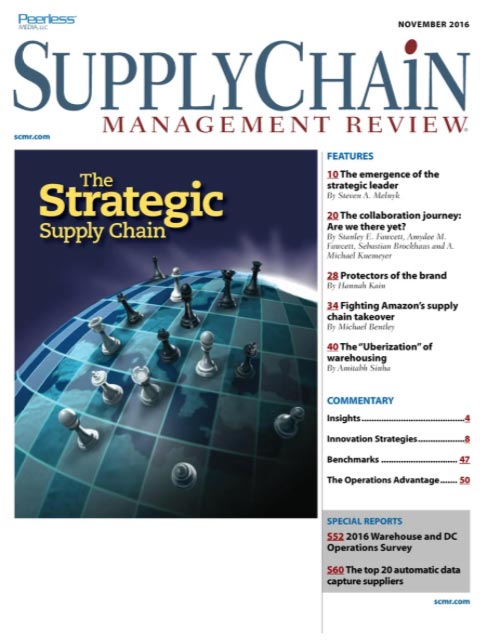Sorry, but your login has failed. Please recheck your login information and resubmit. If your subscription has expired, renew here.
November 2016
Is supply chain management strategic or tactical? Are the best supply chains collaborative? Should the goal be an integrated supply chain or an integrative supply chain? The answers are a mixed bag, according to this month’s contributors. Browse this issue archive.Need Help? Contact customer service 847-559-7581 More options
In August of 2016, Chipotle was riding high. Perceived as a healthy food choice for its use of local, farm fresh ingredients, the Mexican food chain was one of the three most respected limited service restaurants in the world. Neither diners, who flocked to its locations, nor investors, who drove the price of a single share of stock to more than $750, could seem to get enough. Of course, that was before an outbreak of Norovirus in Simi Valley, Calif. that affected nearly 100 customers.
As if that was not enough, the California outbreak was followed by more outbreaks of food borne illnesses linked to Chipotle locations in at least 12 states. The low point may have been reached in February 2016, when the chain temporarily closed all of its locations to address the issue.
Soon, Chipotle’s stock had dropped 47%. The company had lost $10 billion in market capitalization along with its reputation as the healthy restaurant choice. Now dubbed “the most dangerous restaurant stock in the industry,” it was among the least respected restaurant brands among investors. While the Centers For Disease Control and Prevention looked for the culprit, a sign posted in the window of one Chipotle identified the cause: “FYI: We are sorry, but we are temporarily closed due to a supply chain issue.”
 |
This complete article is available to subscribers
only. Click on Log In Now at the top of this article for full access. Or, Start your PLUS+ subscription for instant access. |
SC
MR
Sorry, but your login has failed. Please recheck your login information and resubmit. If your subscription has expired, renew here.
November 2016
Is supply chain management strategic or tactical? Are the best supply chains collaborative? Should the goal be an integrated supply chain or an integrative supply chain? The answers are a mixed bag, according to this… Browse this issue archive. Access your online digital edition. Download a PDF file of the November 2016 issue.
 |
Download Article PDF |
In August of 2016, Chipotle was riding high. Perceived as a healthy food choice for its use of local, farm fresh ingredients, the Mexican food chain was one of the three most respected limited service restaurants in the world. Neither diners, who flocked to its locations, nor investors, who drove the price of a single share of stock to more than $750, could seem to get enough. Of course, that was before an outbreak of Norovirus in Simi Valley, Calif. that affected nearly 100 customers.
As if that was not enough, the California outbreak was followed by more outbreaks of food borne illnesses linked to Chipotle locations in at least 12 states. The low point may have been reached in February 2016, when the chain temporarily closed all of its locations to address the issue.
Soon, Chipotle's stock had dropped 47%. The company had lost $10 billion in market capitalization along with its reputation as the healthy restaurant choice. Now dubbed “the most dangerous restaurant stock in the industry,” it was among the least respected restaurant brands among investors. While the Centers For Disease Control and Prevention looked for the culprit, a sign posted in the window of one Chipotle identified the cause: “FYI: We are sorry, but we are temporarily closed due to a supply chain issue.”
 |
SUBSCRIBERS: Click here to download PDF of the full article. |
SC
MR

Latest Supply Chain News
- Few executives believe their supply chains can respond quickly to disruptions
- Technology’s role in mending supply chain fragility after recent disruptions
- Tech investments bring revenue increases, survey finds
- Survey reveals strategies for addressing supply chain, logistics labor shortages
- Israel, Ukraine aid package to increase pressure on aerospace and defense supply chains
- More News
Latest Podcast

 Explore
Explore
Topics
Latest Supply Chain News
- Few executives believe their supply chains can respond quickly to disruptions
- Technology’s role in mending supply chain fragility after recent disruptions
- Tech investments bring revenue increases, survey finds
- Survey reveals strategies for addressing supply chain, logistics labor shortages
- Israel, Ukraine aid package to increase pressure on aerospace and defense supply chains
- How CPG brands can deliver on supplier diversity promises
- More latest news
Latest Resources

Subscribe

Supply Chain Management Review delivers the best industry content.

Editors’ Picks





